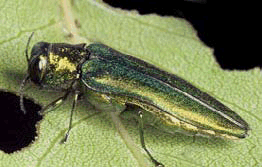Green Horizons
Volume 18, Number 2Spring 2014
Keep an eye on your trees; know your pests
By CHRISTINE TEW
As warmer weather approaches and more people are outdoors enjoying Missouriís resources, it is key that individuals help keep an eye on our stateís trees and for the invasive pests that threaten them.
The Mo. departments of Agriculture, Conservation and Natural Resources, in conjunction with the USDA Animal and Plant Health Inspection Service and University of Missouri Cooperative Extension Service, are working to protect the stateís forests from invasive pests, including the Emerald Ash Borer, Thousand Cankers Disease, Gypsy Moth and Asian Longhorned Beetle.
The Emerald Ash Borer has been found in two areas of the state, in southeastern Missouri and near Kansas City. The insect is readily identified by its shiny, emerald green color and the D-shaped holes it leaves in the bark of Ash trees. Affected trees can also be identified by the distinct S-shaped paths the borers leave in the treeís trunk, beneath the bark.
The Walnut Twig Beetle and Thousand Cankers Disease have not yet been identified in Missouri, although the pest has been found in states to both the east and west. The beetle is dark brown and about the size of the "i" in the word Liberty on a dime. The beetle carries a fungus that causes cankers in the tree, eventually killing even healthy walnut trees.
The European Gypsy Moth attacks oak trees and many other host plants, feeding on the crown of trees and damaging foliage. The moth has been detected in Missouri during annual surveys as far back as 1974, but has not yet become established. These annual early detection surveys will help us to quickly and successfully respond to an outbreak before it can get a foothold in the stateís valuable oak forests. Gypsy Moth caterpillars are hairy and dark grey with red and blue dot pairs running down its back. Adult male moths are brown and have brown waves on their wings. Adult female moths have similar markings, but are typically white.
The black and white mottled Asian Longhorned Beetle primarily attacks maple trees, but can also affect elms, birches, willows, poplars and green ash. The larvae damage trees by tunneling and girdling, and over time attacks can kill even healthy trees. This beetle has previously been identified in major cities - including Chicago and New York - but not in Missouri.
The easiest way to protect Missouriís forests from these and other pests is by preventing their spread into and across the state by leaving firewood at home while traveling. Purchase or gather firewood where it is needed, near where it will be burned.
For more tips and information, and to report a sighting of one of these pests, visit eab.missouri.edu, mda.mo.gov and mdc.mo.gov/node/14790.
 |
||
PHOTO COURTESY OF ISU EXTENSION AND OUTREACH |
||
The Emerald Ash Borer has been found in two parts of Missouri:the southeastern area and near Kansas City. |
||
Got pests? Newly launched Tree Pests website can help
Whether itís a tree in your yard or your 40-acre woodland, the Missouri Invasive Forest Pest Council has launched Tree Pests, a new website containing the latest information on a wide array of invasive tree pests that are threatening Missouriís trees. The site will have specific information on emerald ash borer and thousand cankers disease of black walnut to name a few. You will learn how to identify the invasive pest, where it has been found in Missouri, up-to-date plant quarantine information from the Missouri Department of Agriculture, control measures, and how to report a suspect tree to the proper authorities. You can find Tree Pests at http://treepests.missouri.edu. So, check it out today and help us slow the spread of these harmful invasive pests!